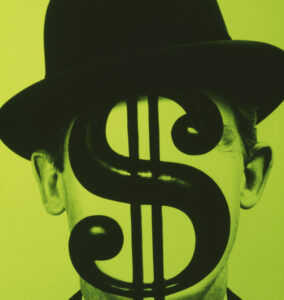Ten years ago, I was in a basement bar in Shoreditch, the fashionable part of London that had adopted the moniker “Silicon Roundabout” thanks to the confluence of tech firms there. I was speaking to one of the many salons that had popped up in the wake of the 2008 crash, before an audience of 30-something creatives and digital entrepreneurs. The topic of the day: the still-new technology of cryptocurrency. When I finished, I added that if anyone had a few quid to spare, they might consider taking a punt on this thing called Bitcoin. Then trading at about $100, I expected it to surge in price over the coming years — though it would be a wild ride, because it might eventually crash to oblivion. “Get in to get out,” I advised.
We knew little about Bitcoin’s creators, other than that they were angry at how the 2008 crash had been managed and wanted to create an alternative form of money to liberate people from banks. Set up using blockchain technology — a decentralised, digital record on a peer-to-peer network — Bitcoin transactions could take place without the need for a central clearing authority. Yet despite all the excited chatter that evening about the new businesses that could take payments or process transaction in cryptocurrencies, few of them went far. That’s because Bitcoin, with its volatile pricing and high transaction costs, wasn’t really behaving like money. But I also suspected that didn’t matter. Because built into its design was a limit to how many Bitcoins could be produced, a feature that would enable it to exploit a design flaw in central bankers’ monetary policy — and ultimately reveal the façade of so much “wealth-creation” in the past decade.
At the time of the 2008 crash, a strict theology governed economic policy-making in Western countries. It held that monetary policy, determined by an independent central bank, should dominate economic management and should support the private banking system to the best of its ability. For obvious reasons, the crash spurred demand for change to this model across the political spectrum. But the economic policy establishment scarcely noticed. Instead, it faithfully applied its doctrine. The banks were bailed out and, to ensure asset prices quickly bounced back, central banks flushed the financial system with cheap money, and not just with its traditional method of cutting interest rates.
Starting at the US Federal Reserve and then following on in 2009 at its British and European counterparts, central bankers adopted a bold new policy that had been pioneered in Japan: essentially handing money to banks by buying their bonds at near-zero interest, something they called quantitative easing. The theory, derived from studies of the Great Depression, was that by pouring money into the corporate sector, the central bank could get businesses to invest and thereby create new jobs. But economies had changed a great deal over the intervening century, and rather than kickstart a recovery, the money flowed into existing assets, producing big bull runs in stocks, bonds and real estate. Still, central banks were happy, saying the resulting wealth effect — asset-owners feeling richer — spurred consumption, and supported economic growth.
But that’s not necessarily how ordinary folk saw matters. Real wages remained stagnant, even as house prices and rents on homes or new business premises were all rising by the month. And not coincidentally, these were the years of populist rage against elites and “experts”. But while some took to the streets, a secondary revolt took place: infiltration of the financial system. Enter Bitcoin, which offered a means to hack the regime of quantitative easing. Since its supply was fixed, any portion of the wave of money that central banks pumped into markets which was used to buy Bitcoin would drive up its price, inflating a bubble.
That’s just what happened. By 2021, that $100-a-pop trade I’d touted back in 2013 had soared past $60,000. And on its vertiginous journey, as others saw the easy money to be made off gaming monetary policy, spin-offs multiplied, from non-fungible tokens to meme stocks on trading boards. Such innovations took on a sharp political edge on Reddit boards such as r/wallstreetbets, where traders organised short squeezes that caused losses at big funds, and then celebrated those victories. “We have a once in a lifetime opportunity to punish the sort of people who caused so much pain and stress a decade ago,” wrote one user in 2021, “and we’re taking that opportunity.” But though such victories were usually fleeting, and the new inventions not only ethereal but often utterly ultimately meaningless, they succeeded in making their point. What amounted to currency debasement by monetary authorities had meant that what was worthless could become priceless.
The fact that cryptocurrency was more or less imaginary, that it had no physical reality, that it was nothing more than a sort of elaborate confidence act, was beside the point. That’s true of all money. Although we rational moderns claim to believe only in “facts”, and thus impart the language of cold empiricism to any talk of money — hard cash, real money, solid gold — in reality few things are less concrete. We think of money as cash, but cash is insignificant in the money supply (when was the last time you used it?). We think the government prints it, when we actually create it ourselves from thin air via bank-borrowing. The government can’t even be sure how much money exists.
Nevertheless, we’re willing to transact business with millions of people we’ll never meet, using a medium of exchange we don’t understand, simply because we trust in its fungibility and solidity. Those figures in our banking apps may be nothing more than code on a server, but we trust them to still be there tomorrow, to have essentially the same value today as they did then, and to be available as a universally accepted means of payment. The whole system is backed by an elaborate financial and legal architecture, mediated by a central bank, and is ultimately grounded in our faith. And that faith has enabled us to do miraculous things, from developing new technologies to lifting billions from poverty.
But faith is also fragile and easily broken. When we lose it, when people begin to doubt the solidity of money, inflation results. So when central banks waved off surging asset-prices as not real inflation, many took it as a betrayal, for it was plain to see that asset-price inflation benefited some more than others. It looked suspiciously like central banks were increasing the value of money used by owners while debasing the money used by workers. The modern priesthood revealed itself to be manipulating our faith to serve the ruling class, and the temple erupted in rebellion.
Mainstream economics claimed it “saved the world” in 2008. But they provided the material conditions for the crisis of political faith across the West since that fateful year, first in the way the economic models used at the banks helped cause the crash, and then through a recovery which generated wealth for owners and immiserated workers. And amid all the self-congratulation, central banks and economists took no heed of the multiplying signs of distress that their crisis produced: the explosion of street protests, the declining support for democracy, the epidemics of mental illness and “deaths of despair” in America. All such dysfunction was dismissed as outside the bounds of macroeconomic theory. So the vandals infiltrated the system and made the “experts” notice where it hurt, in the asset-markets.
After a decade of sucking up the cost of asset-price increases, workers recently started to claim back some of their losses with stronger wage gains, changes in labour markets having improved their bargaining power. But rather than cut the record profit-margins attained during the pandemic to absorb the cost, firms have simply passed the bill to consumers, leading to the consumer price inflation we now see. No longer able to pretend inflation isn’t a problem, central banks have had to tighten monetary policy aggressively. When that tightening began, when it appeared the era of cheap money had finally ended, Bitcoin crashed.
But when the ructions began spreading through the US banking system again recently, central banks eased up on the money brakes. Bitcoin rallied once more. And so it will continue. Investors are betting the days of cheap money will soon be back and have begun buying again and driving down interest rates. Central banks are insisting the pause is only temporary, and they are determined to stamp out inflation. So they now face a painful dilemma. They can prosecute their war on inflation and clamp down on the money supply, standing by while investors and fund managers wail over their losses. Or they revert to their old ways: heed the call of asset markets, keep prices rising, and allow inflation to linger, which would amount to a dereliction of their duty to the economy as a whole.
To know which way the wind is blowing, watch Bitcoin, the imagined currency that has become real, and is our most useful measure of faith in global finance. If central banks revive the neoliberal theology of 2008 — rescue the owners, forget workers — they will continue to lose their congregation as the apostates flock back to cryptocurrencies. But while a renewed bitcoin surge would indicate a deepening of the crisis of faith, there are signs that economists, and even some central banks, are noticing. New voices have begun pushing back on the dogma that generous social spending or rising wages cause inflation, and some central banks are even starting to admit that maybe, just maybe, it’s excess profits that are the inflation bugbear.
Bitcoin may still crash. But if along the way it shamed the priesthood into serving the people, it will have been no mean feat.
Disclaimer
Some of the posts we share are controversial and we do not necessarily agree with them in the whole extend. Sometimes we agree with the content or part of it but we do not agree with the narration or language. Nevertheless we find them somehow interesting, valuable and/or informative or we share them, because we strongly believe in freedom of speech, free press and journalism. We strongly encourage you to have a critical approach to all the content, do your own research and analysis to build your own opinion.
We would be glad to have your feedback.
Source: UnHerd Read the original article here: https://unherd.com/




